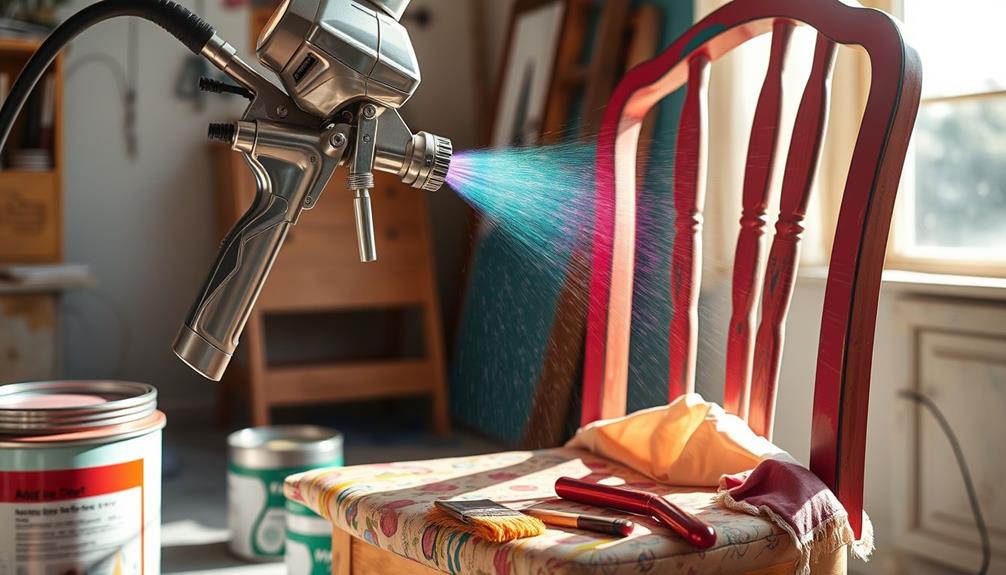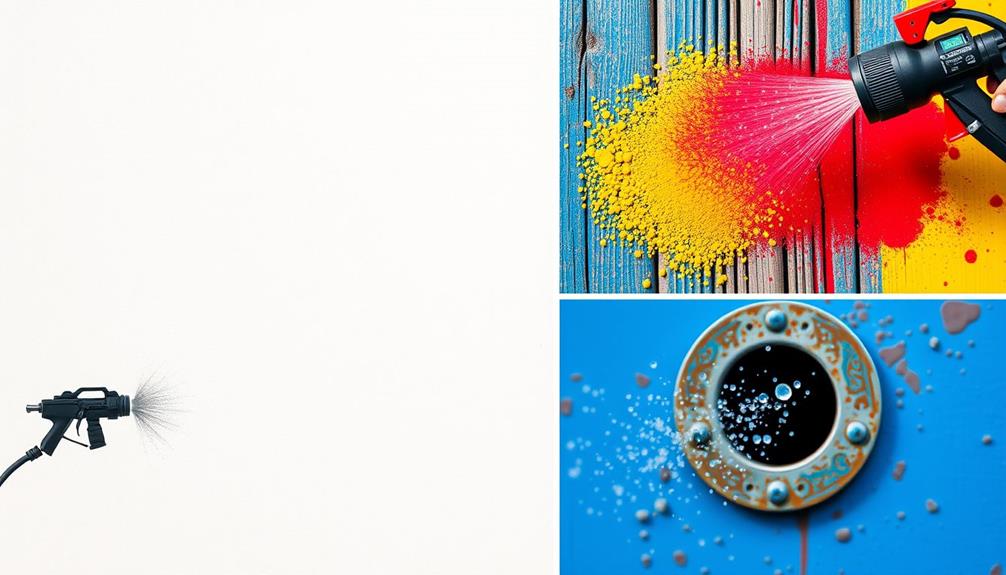To properly dispose of leftover paint from your airless sprayer, first, identify if it's latex or oil-based. For latex paint, let it dry out by mixing it with cat litter or sawdust, then throw it in your regular trash. Oil-based paint is hazardous, so take it to a specialized disposal site to prevent environmental harm. Never pour paint down drains. Also, always check your local regulations for collection events and recycling options. Following these steps makes disposal safe and responsible, allowing you to maintain a clean environment and your home. There's more essential info to contemplate.
Key Takeaways
- Solidify leftover latex paint by mixing it with cat litter or sawdust before disposing of it with regular household waste.
- Take oil-based paint and completely empty spray paint cans to designated hazardous waste collection sites for safe disposal.
- Clean the airless sprayer outdoors to manage dirty water disposal and enhance indoor air quality.
- Return excess paint from the sprayer's pickup tube to its original container to minimize waste and avoid overbuying.
- Stay informed about local disposal guidelines and community resources for responsible paint disposal to prevent environmental contamination.
Understanding Leftover Paint
Leftover paint often accumulates after a project, and it's important to understand what you're dealing with. You might find yourself with excess latex paint or oil-based paint, both of which require different disposal methods.
Latex paint, which is water-based, is generally non-hazardous when fully dried. This means you can dispose of it with your regular household waste. However, if it's still wet, you should let it dry out or mix it with something like cat litter to solidify before tossing it out. It's also wise to reflect on the significance of understanding service costs when hiring professionals for projects that may involve paint.
On the other hand, oil-based paint is regarded as hazardous and must be taken to specialized disposal sites. Ignoring this can lead to environmental contamination.
Be mindful of dirty water from your sprayer, too, as it may contain paint residues that need proper handling.
Many communities have specific guidelines for disposing of leftover paint, including hazardous waste collection events and recycling programs. Knowing the type of paint you have and your local regulations is essential. This guarantees safe disposal and helps mitigate potential health risks associated with paint waste.
Types of Paint Waste
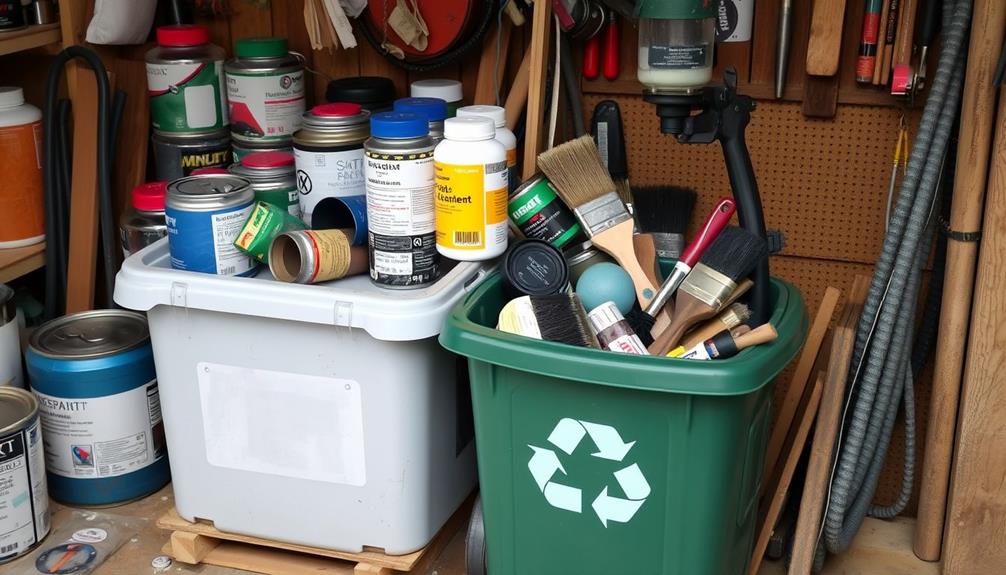
Understanding the different types of paint waste is essential for responsible disposal. Each type requires specific handling to minimize environmental impact and comply with local regulations.
| Type of Paint Waste | Disposal Method | Environmental Impact |
|---|---|---|
| Latex Paint Waste | Solidify with cat litter or paint hardeners, then discard in trash | Non-hazardous when dry |
| Oil-Based Paint Waste | Dispose at hazardous waste collection sites | Can contaminate water sources |
| Spray Paint Waste | Completely empty cans; dispose at hazardous collection events | Pressurized and potentially harmful |
| Waste Water from Cleaning | Avoid pouring down drains; consider dilution before disposal on lawns | Can affect wastewater treatment plants |
| Local Regulations | Research specific disposal methods for each paint type | Compliance protects the environment |
Safe Disposal Methods
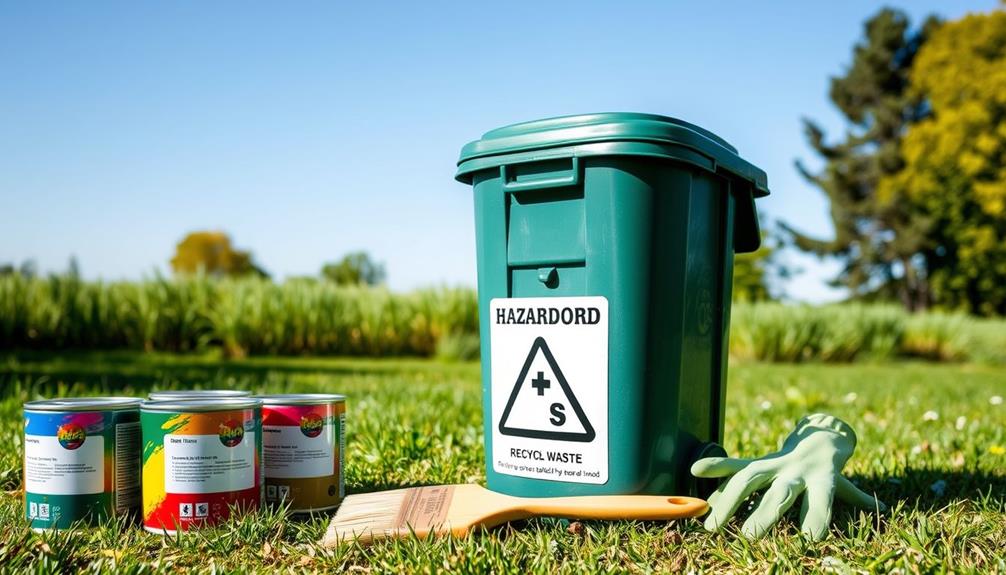
When it comes to safely getting rid of leftover paint, you've got some effective options.
Start by using proper paint hardening techniques, which can help prevent harmful chemicals from contaminating the environment. Additionally, consider using air purifiers to improve indoor air quality as you work with paint, guaranteeing that any airborne particles are minimized.
Then look into eco-friendly disposal methods that suit your needs.
Proper Paint Hardening Techniques
Often, you'll find that properly hardening leftover latex paint is crucial for safe disposal. To do this, you can mix the paint residue with cat litter or sawdust. These materials absorb the moisture, helping the paint solidify more effectively before you toss it in the trash.
Additionally, be mindful of the environmental impact of improper disposal, which is similar to flushing non-flushable items like baby wipes that can clog sewer systems toilet disposal practices.
Alternatively, using a commercial paint hardener can expedite the drying process, guaranteeing the paint is safe for regular garbage disposal once it's solidified.
If you prefer a more natural method, allow the latex paint to air dry in a well-ventilated area. Place the paint in a shallow tray to maximize surface area, which speeds up evaporation.
For smaller amounts, pouring the paint into a cardboard box lined with plastic works well too. Just make sure to keep it contained.
Always remember to check local regulations regarding paint disposal. Some areas have specific guidelines for handling hardened paint to guarantee environmental safety.
Eco-Friendly Disposal Options
Eco-friendly disposal options for leftover paint can considerably reduce your environmental footprint. Proper disposal methods are essential, especially considering the potential hazards associated with certain types of paint. Here are some effective methods you can use:
1. Dry It Out: Let leftover paint dry in a lined cardboard box or mix it with cat litter or a commercial paint hardener before tossing it in the regular trash.
2. Spread Water-Based Paint: For water-based latex paints, spread thin layers on newspaper to allow quick evaporation. Once dry, dispose of the newspaper in the trash.
3. Hazardous Waste Sites: Use designated hazardous waste collection sites for oil-based paints and spray paints, as these need special handling due to their flammable nature.
It's important to stay informed about local regulations, similar to how communities discuss home security concerns for better safety practices.
4. Engage in Forums: Join local forums to stay updated on community collection days for paint disposal, ensuring you're following responsible practices.
Always remember to avoid pouring paint or wastewater down drains or storm sewers, as this can contaminate water sources and is often illegal.
Local Regulations Overview
Maneuvering local regulations for paint disposal can seem intimidating, but understanding the specific requirements in your area is fundamental for safe practices.
Most local regulations mandate that leftover paint and paint waste must be taken to designated hazardous waste collection sites. This is critical to prevent environmental contamination and guarantee compliance with safety standards related to hazardous materials.
Check if your municipality has specific hazardous waste disposal days. These events allow you to safely drop off unusable paint and other toxic materials without worry.
Be aware that improper disposal can lead to fines and negatively impact local ecosystems, so it's essential to familiarize yourself with local by-laws regarding paint disposal.
Some communities offer automated systems or collection events specifically for dried paint in its original containers, enhancing safety and compliance with local regulations.
To stay informed, utilize community resources like local environmental groups and municipal websites. They often provide guidelines and updates on safe disposal methods for leftover paint.
Environmental Impact Considerations
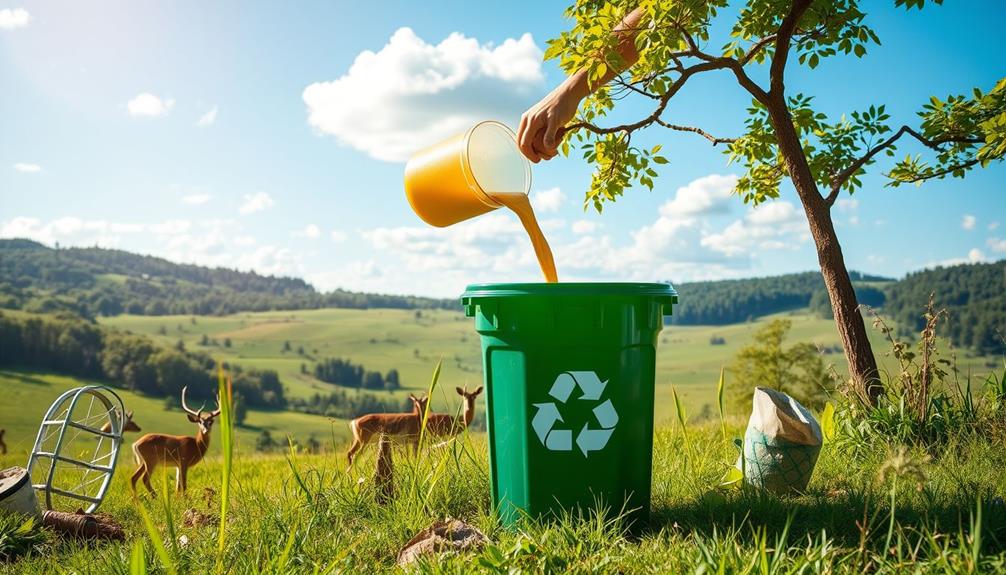
When you dispose of leftover paint, it's essential to reflect on its toxicity and how it can harm local ecosystems. Many areas have regulations that prohibit improper disposal, like pouring paint down storm drains, to protect water quality and wildlife.
To make a positive impact, you should adopt sustainable disposal practices that minimize environmental harm. For instance, using eco-friendly materials not only helps in construction but also in reducing hazardous waste.
This commitment to sustainability can extend to various aspects of home maintenance, ensuring a healthier environment.
Toxicity of Paint Waste
Proper disposal of paint waste is vital for safeguarding our environment and health. The toxicity of paint waste, particularly from oil-based products, poses significant risks. Here are some key points to reflect upon:
1. Volatile Organic Compounds (VOCs): These compounds can contribute to air pollution and may affect indoor air quality, similar to the effects of improper heat pump maintenance which can lead to increased emissions.
innovative heat pump technology is being developed to mitigate such environmental impacts.
2. Groundwater Contamination: Even latex paints can leach harmful ingredients into groundwater if not disposed of properly.
3. Ecosystem Impact: Wastewater treatment plants may not fully eliminate contaminants, risking local ecosystems when treated water is released.
4. Long-term Contamination: Pouring paint down storm drains or onto the ground leads to lasting soil and water contamination, harming wildlife and human health.
To combat these issues, it's imperative to adopt proper disposal methods. Always check local regulations and guidelines for safe disposal options.
By being responsible with paint waste, you help protect our environment and guarantee a healthier future for all.
Local Disposal Regulations
Maneuvering local disposal regulations is essential for ensuring that leftover paint doesn't harm the environment. Many municipalities have specific guidelines for disposing of paint waste, particularly for oil-based varieties, which must often be dropped off at designated hazardous waste collection sites.
To stay informed, check your local government's website for up-to-date information on disposal events and locations. Understanding how to effectively increase topical authority surrounding local disposal regulations can also aid in spreading awareness in your community.
Environmental impact considerations are critical when managing your paint disposal. Pouring paint down storm drains can lead to pollution of local water bodies, posing a threat to aquatic life. The rules for proper disposal can vary considerably by region; some areas may offer recycling programs for latex paint, while others strictly prohibit disposal in general waste.
Awareness of local bylaws regarding paint disposal is essential. Improper disposal can't only result in hefty fines but also contribute to larger environmental issues.
Sustainable Disposal Practices
Sustainable disposal practices for leftover paint are essential in reducing your environmental footprint. Proper disposal methods can help prevent contamination and promote eco-friendliness. By implementing effective strategies, you can enhance your commitment to sustainability and protect your local ecosystem, as seen in AI security's role in protecting sensitive data.
Here are some key practices to reflect on:
- Never pour paint down storm drains – This can contaminate local water systems and harm aquatic life.
- Dried latex paint can go in the trash – Once solidified, it's safe to dispose of non-hazardous latex paints with your regular waste.
- Take oil-based paints to hazardous waste collections – Due to their flammable nature, these require special handling at designated sites.
- Use drying techniques – Speed up drying by pouring excess paint into a shallow tray or mixing it with cat litter.
Awareness of VOCs' harmful effects on air and water quality underscores the importance of these proper disposal methods.
Community Disposal Resources
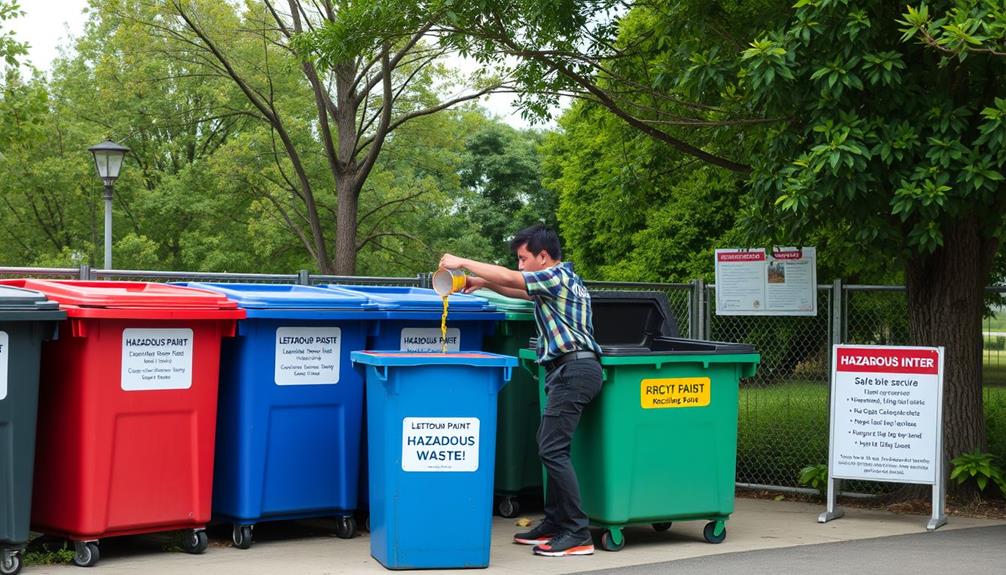
When you're ready to dispose of leftover paint, checking with your community's resources can make the process easier and safer. Many communities organize hazardous waste collection events, where you can drop off leftover paint and other hazardous materials. These events guarantee your paint is handled correctly and recycled responsibly.
Additionally, some communities offer water parks in Washington DC that feature family-friendly activities, promoting environmental awareness through fun attractions.
Local municipalities often have permanent hazardous waste disposal sites that accept paint. You can usually find this information on community boards or local government websites. They often list upcoming disposal days, providing you with specific guidelines for paint disposal.
Additionally, some hardware stores and paint retailers partner with recycling programs, allowing you to return unused or leftover paint for safe disposal. This option not only helps you get rid of the paint but also supports environmentally friendly practices.
Engaging with local environmental organizations can also be beneficial. They often provide additional insights and resources on responsible paint disposal practices in your area.
Donation Options for Usable Paint
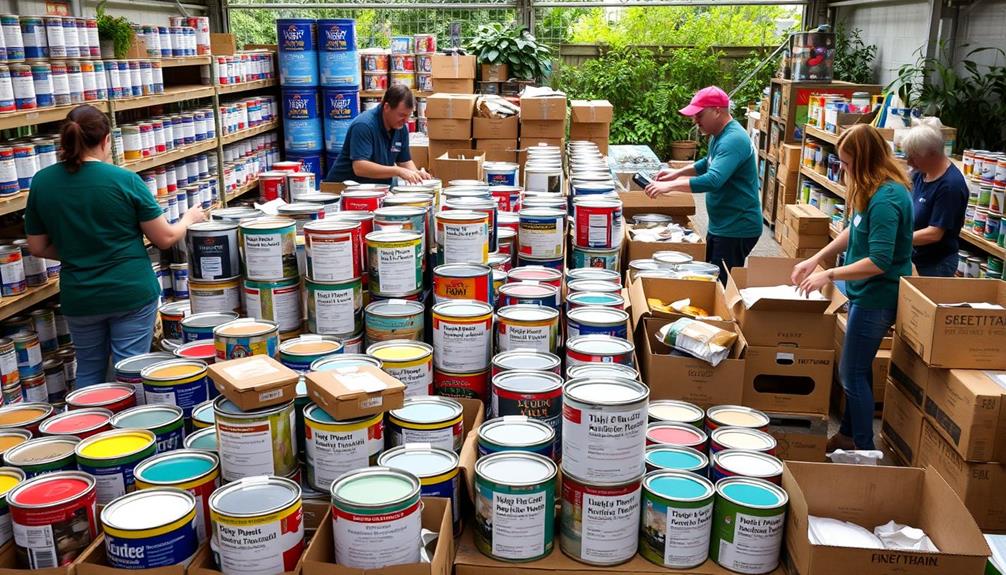
Considering your leftover paint options, donating usable latex paint can be a great way to give back to the community while keeping hazardous materials out of landfills.
If your paint meets the following criteria, it's a worthy contribution:
- Original Condition: Confirm the paint is in its original, unopened container.
- Readable Labels: Labels must be intact and legible.
- Good Condition: The paint should be free from contamination and not expired.
- Latex Only: Remember, only latex paint is eligible; oil-based or spray paints can't be donated.
Many community organizations, like The Green Project, welcome donations of usable latex paint to redistribute to local artists and low-income families.
This not only supports home improvement projects for those in need but also promotes recycling efforts.
Before donating, it's essential to check your local regulations, as guidelines can differ by location.
By donating your leftover latex paint, you're actively participating in a sustainable practice that reduces waste while helping others in your community.
Mistakes to Avoid in Disposal
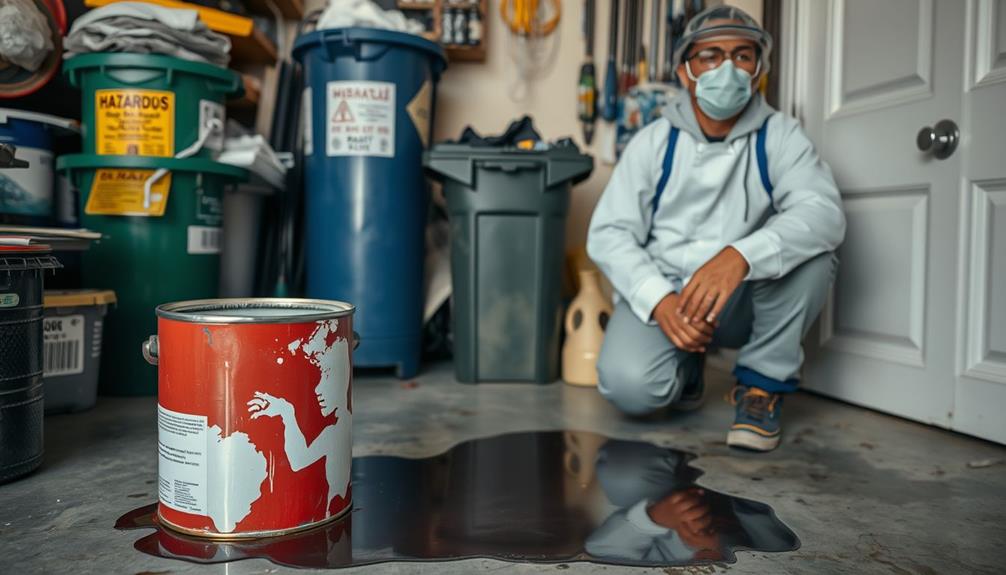
Proper disposal of leftover paint is essential for protecting the environment, so it's important to avoid common mistakes that can lead to pollution or legal issues. One major error is pouring leftover paint or dirty water down storm drains. This practice can cause significant environmental contamination and is often illegal. Instead, look for proper disposal methods.
Don't toss liquid paint in your household trash without first drying or solidifying it. Local regulations usually require this step to prevent pollution. Additionally, never mix oil-based paints with regular trash; these are classified as hazardous waste and must be taken to designated disposal facilities.
Another mistake is overbuying paint. To minimize waste, use online calculators to determine the right amount needed for your project.
Proper Cleaning of Airless Sprayers
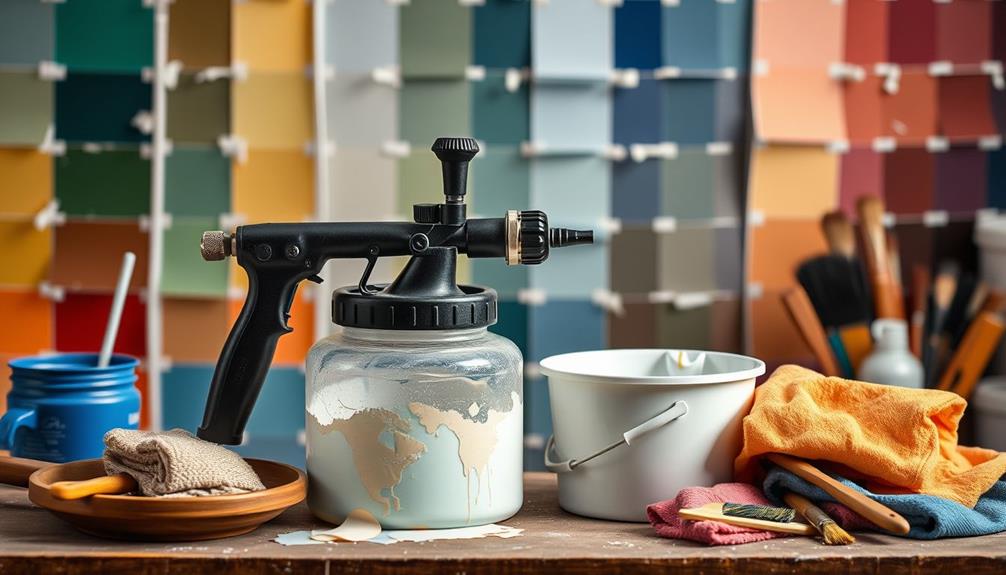
Cleaning your airless sprayer after use is essential for maintaining its efficiency and longevity. Proper cleaning of airless sprayers not only guarantees peak performance but also helps prevent future clogs.
Here's a quick guide to help you:
- Remove excess paint from the pickup tube and return it to the paint container to minimize waste.
- Use clean water to prime the sprayer, spraying any leftover paint into a holding tray. Let the water evaporate to further reduce waste.
- Regularly flush the system with warm water to keep everything running smoothly.
- Scrape any dry residue from the holding tray into a trash can for proper disposal, avoiding environmental contamination.
It's also recommended to clean airless sprayers outdoors. This helps you manage dirty water disposal responsibly while minimizing the impact on indoor air quality.
By following these steps, you're not only guaranteeing the proper cleaning of airless sprayers but also extending their lifespan.
If you're facing persistent issues or heavy buildup, consider creating a new cleaning routine to tackle the problem effectively.
Local Regulations and Guidelines
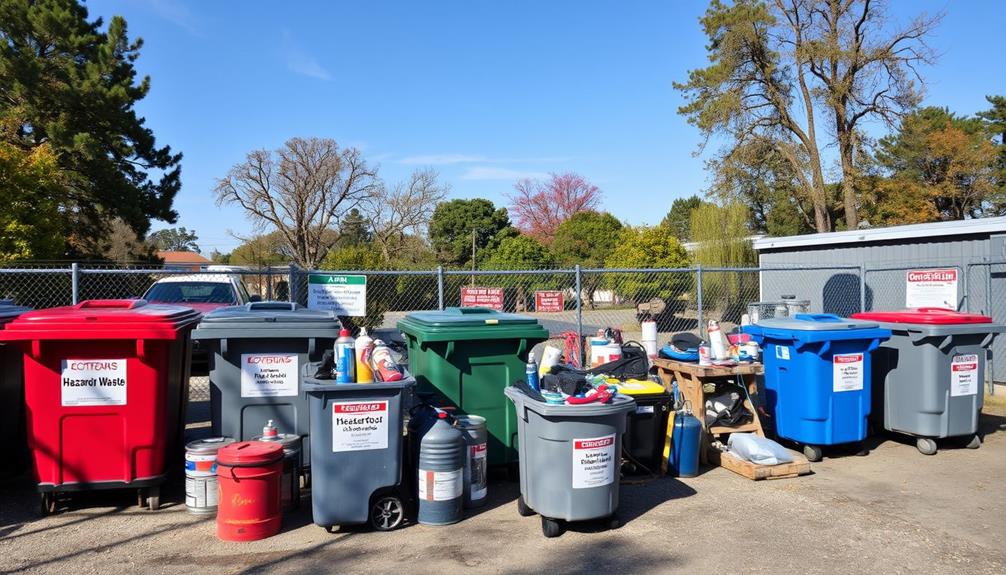
When it comes to disposing of leftover paint, you need to follow local regulations to guarantee you're doing it right.
Many communities have specific guidelines and designated collection days for hazardous waste, including paint.
Always check with your waste management authority for the best practices in your area to avoid fines and protect the environment.
Local Disposal Regulations
Managing local disposal regulations for leftover paint can feel overwhelming, but it's essential for both safety and compliance. You need to be aware of your area's specific rules to avoid penalties and guarantee proper disposal.
Here's what to keep in mind:
- Check with your municipal waste management authority for local disposal regulations.
- Look for designated hazardous waste collection days or sites in your community.
- Only pour diluted latex paint down household drains if local regulations permit it.
- Bring oil-based paints to a hazardous waste collection site, as they're classified as hazardous materials.
Staying informed is key; local regulations can change, and what was acceptable yesterday mightn't be today.
By following these guidelines, you'll not only comply with local laws but also contribute to environmental safety.
Hazardous Waste Guidelines
Disposing of leftover paint requires careful attention to hazardous waste guidelines, as local regulations often classify oil-based and spray paints as hazardous materials.
To guarantee you're complying with the laws, start by checking your local government or environmental agency's website for updated disposal guidelines. These regulations can vary considerably by region, so it's essential to get the most accurate information.
Many municipalities provide designated drop-off locations or collection events for hazardous waste, making it easy for you to safely dispose of leftover paint.
Participating in these events not only helps you get rid of unwanted materials but also protects the environment from contamination.
Some communities even offer paint recycling programs that accept usable latex paint, promoting reuse and reducing landfill waste.
Best Practices for Paint Management

Effective paint management not only saves you money but also helps reduce environmental impact. By following these best practices, you can minimize paint waste and guarantee proper hazardous waste disposal:
- Return Excess Paint: Always remove excess paint from the sprayer's pickup tube and return it to the original container. This simple step considerably reduces waste.
- Flush the Sprayer: Clean your airless sprayer with clean water, spraying any leftover paint into a holding tray. Let the water evaporate to minimize waste volume.
- Avoid Water Contamination: Never dispose of paint waste in storm drains or local waterways. Instead, check local regulations for proper hazardous waste disposal methods.
- Solidify Leftovers: Use a commercial paint hardener or mix leftover latex paint with cat litter to solidify it before throwing it away in regular trash.
Regular maintenance of your airless sprayer, including thorough cleaning after each use, also helps reduce leftover paint.
Frequently Asked Questions
What to Do With Leftover Spray Paint?
When you have leftover spray paint, spray it out on cardboard until empty. If it's still usable, consider donating it. Always check local regulations for proper disposal methods to avoid environmental harm.
What Is the Disposal Method of Leftover Paint?
When you've got leftover paint, check local guidelines first. For latex, mix it with cat litter to solidify before tossing. Oil-based paints need special handling—take them to hazardous waste sites for safe disposal.
How Do You Empty an Airless Paint Sprayer?
To empty your airless paint sprayer, remove excess paint from the pickup tube, return it to the container, and prime with clean water. Spray any leftover paint into a holding tray for cleanup.
How Do I Get Rid of Spray Paint Cans?
Think of spray paint cans as empty canvases, waiting for their next masterpiece. To get rid of them, make certain they're fully empty, then check local rules for disposal—some might need a special touch at hazardous waste centers.
Conclusion
In conclusion, properly disposing of leftover paint not only protects the environment but also keeps your workspace safe. While it might be tempting to pour it down the drain, remember the long-term consequences of such choices. Instead, embrace responsible disposal methods and community resources that help you manage waste wisely. By balancing convenience with care, you guarantee a cleaner future for everyone while maintaining the beauty of your projects. Paint responsibly, and let your creativity thrive!



